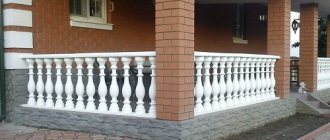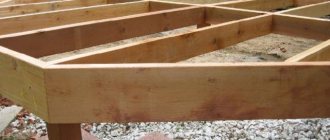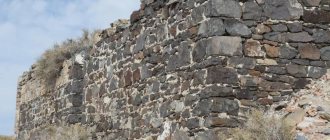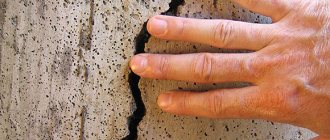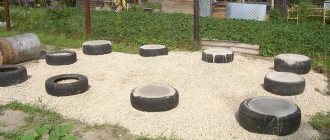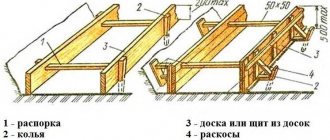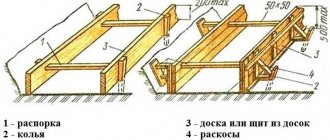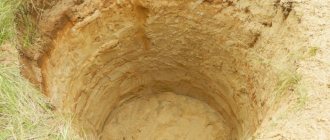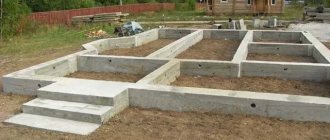Beton-House.com
Website about concrete: construction, characteristics, design. We combine the experience of professionals and private craftsmen in one place
Rubble concrete structures
The rubble concrete strip foundation is one of the types of monolithic foundation. A rubble concrete foundation differs from a classic strip structure in that pieces of natural stone (rubble) are pressed into the concrete mixture laid in layers. This method of constructing a foundation allows for significant savings in materials, while the strength of such a structure is in no way inferior to other similar systems.
The foundation for a country house made of natural stone can be rubble or concrete. What brand of concrete is needed for a strip foundation using rubble stone, and what technology is used to construct a foundation for a house for individual use from the above materials is the main topic of this article.
- Materials Concrete mix
Material characteristics
Rubble concrete is a type of concrete, the coarse filler of which is natural stones of irregular shape and fragments of bricks. Broken blocks with low strength and high porosity are not suitable for use - compared to the rest of the concrete mass, they have reduced reliability and are subject to destruction under intense loads.
The technical characteristics of rubble concrete depend on the properties of the filler.
For example, a structure with broken bricks weighs slightly more than one with large crushed stone or rubble. Due to the heterogeneity of materials, it is impossible to identify certain characteristics of rubble concrete. Here are the average data:
- the volumetric weight (density) of rubble concrete is determined by the brand of binder and coarse filler used, on average 2300...2900 kg/m³; the mixture contains 40-60% large stones, which affects the weight of the structure; the strength of rubble concrete is determined by the brand of cement, but Due to the characteristics of the material, it is not easy to calculate. Experts use a binder of a higher grade than the expected strength of the stone; for example, to mix M200 rubble concrete they use M400 Portland cement.
The specific gravity of rubble concrete is difficult to determine; in practice, this is not done because it is unnecessary - the properties of the fillers change, so the average value for the density and mass of materials is taken.
Covering the base with natural stone slabs
As a rule, this type of material has quite a noticeable weight, so in rare cases it is permissible to attach it only to a solution. When using this method, a special reinforcing mesh must be placed on top of the base, which will ensure reliable fastening of the slabs to the surface.
Basically, special anchors or fasteners are used for fastening, which are installed during the process of laying the panels on the mortar.
In this case, it is mandatory to tie each finishing element to the base.
- Fasteners are special hooks made of stainless steel, and each plate requires at least two fasteners on top and bottom. To install them, holes are punched in the natural stone slabs into which the hook is inserted, while the second part must be mounted into the base.
- When installing fasteners in slabs, it is necessary to cut out grooves so that the hook does not protrude beyond the surface of the panel.
Scheme for installing foundation cladding slabs - The hooks themselves are strengthened in the body of the slab using an adhesive solution.
- Additionally, the slabs themselves are secured to each other with similar hooks.
- The laying of natural stone slabs begins from the corners of the building; all the rest are oriented along the slabs of the bottom row. All other activities for finishing the base are carried out as in previous cases.
This simple method allows you to give the visible part of the foundation a presentable appearance with a minimum of costs for purchasing consumables; do not forget about additional protection of the base from environmental influences.
Components
The composition of rubble concrete for the foundation includes several main components:
- rubble stone (40-60%); river sand of medium fraction; cement M400, M500; water; plasticizers.
Natural rubble stone can be any size with one limitation - the length of the fragments should not exceed 1/3 of the width of the foundation wall. You can use half-bricks and fragments of ceramic blocks, large crushed stone, and rock clastics. Rubble stones must first be cleaned of plaque and dirt by screening or washing with a stream of water.
High grade cement M400-M500 is suitable for obtaining a structure of optimal strength corresponding to M300-M400.
Purified river sand is included in rubble concrete as a fine filler. It is used with cement in a ratio of 3 to 1, maybe 2 to 1 to improve the strength of the structure.
Plasticizers are recommended to be added to the cement mortar for the foundation in order to improve its plasticity and laying. These can be modifier additives to increase the frost resistance of the material and water resistance.
Water is added to the solution as needed in small doses.
The consumption of ready-made cement mortar per 1 cubic meter of rubble concrete is 40-60%, depending on the amount of rubble in the volume of the structure.
The exact composition of the components is determined structurally and depends, again, on the rubble filler.
Features of a rubble concrete foundation
Unlike a conventional concrete foundation, a rubble structure is laid out in the same way as a block foundation; the stones are not mixed in the mortar. This is the difficulty: the stones must be laid, not poured into formwork, and their specific shape requires a professional approach. The installation of a rubble concrete foundation should be done by masons, this way you can get a tape of maximum strength, it will be durable and reliable.
It is advisable to include reinforcement in the tape - even for a small structure, additional insurance in the form of strengthening the base will not hurt.
Foundation advantages:
- reduced cost of construction due to the use of rubble stone and broken brick (the latter can often be obtained for free). During construction, it is possible to save up to 30% compared to the construction of a classic reinforced concrete strip; the durability and reliability of a properly equipped structure made of rubble concrete is not inferior to other types of foundations; a base made of rubble concrete looks impressive and does not require additional cladding, especially if natural stone was used for installation. In this way, you can set up the wall from base to wall without transitions; the foundation is suitable for construction on any type of soil except floating; even a non-professional can do the installation, but it will take a little more time than a mason; a special feature of a foundation made of rubble concrete is that it can easily withstand freezing and defrosting, suitable for installation in all climate zones.
The material's resistance to low temperatures makes rubble concrete an ideal material for construction in winter. A fragile structure can be left unprotected when it reaches 50% of its design strength.
The disadvantage of the design is that despite the abundance of information about rubble concrete, choosing the ideal composition of this material is not easy even for a professional. It is important to consider the characteristics of the stones used as coarse filler.
Selecting and preparing rubble stone for laying the foundation - tips
The quality of rubble for laying foundations for residential buildings is determined very simply. You just need to hit the stone well with a regular hammer. If the bottle does not break from a strong blow and at the same time produces a clear and ringing sound, it means that you have excellent material in front of you.
Stones are also checked for quality by splitting them. If you break the rubble, and it does not generate dust and does not break into small fractions, feel free to use it to build a foundation. Believe me, a foundation made of such stone will last for many decades.
Rubble house foundation
The rubble must be washed before laying. This procedure, let’s say right away, is labor-intensive. Please be patient and have some free time. You have to thoroughly wash every stone. If this is not done, the concrete mixture will not bond with the stones at the proper level, which will significantly worsen the strength of the foundation.
Large pieces of rubble for laying the foundation of a house require additional preparation - breaking them into smaller stones weighing no more than 30 kg. This procedure is called plinting. It is done with your own hands using the following technology:
- Using a soft pencil, draw a line on the stone along which you plan to break the rubble.
- Stretch the nylon rope and forcefully press it into a piece of pre-prepared chalk.
- Pull the cord marked with chalk over the line marked on the stone and suddenly release the rope. As a result, you will get a clearly visible chalk mark on the rubble. This is where the material needs to be split.
- Use a hammer to drive a steel chisel into the cut line on the rubble. You are splitting a stone. The hammer blow should be performed quite firmly. Do not be afraid. A high-quality stone, as we said, will not crumble, but will clearly separate into separate fractions along the split line.
Now that the material has been prepared, you can proceed directly to laying the foundation for the house.
Scope of application of rubble concrete foundation
A strip foundation made of rubble and concrete can be laid on any soil. Due to its obvious cost-effectiveness, it is used for construction:
- baths; low-rise suburban construction; garages; utility buildings.
Rubber concrete can be sensitive to moisture with porous or ceramic filler, which should be taken into account during construction.
Flaws
Like any type of foundation, a rubble concrete strip foundation, in addition to its advantages, has some disadvantages:
- at the first stage you need not to make mistakes when calculating the parameters of the foundation for the house;
- long laying period due to the large volume of earthworks and stone sorting;
- work is performed at a temperature not lower than 5 degrees;
- when the building is more than 5 floors high, the rubble concrete foundation requires reinforcement with steel reinforcement.
A rubble concrete foundation will serve as a reliable foundation for the house if the installation technology and the requirements of all regulatory documents are observed.
Sizing
Determining the parameters of the tape is a priority task. What the width and height of the foundation wall will be depends on the type of soil and the thickness of the vertical wall structures.
The height of the underground part of the foundation can be of two types:
- shallow depth does not reach the lower freezing level of the soil, depends on the mass of the building - for a light structure on a solid foundation, you can take 20-30 cm, for a one-story house or bathhouse - about 50 cm. Normal depth below the freezing level is rarely used when working with rubble concrete.
To the accepted height we add the size of the base - at least 20 cm, optimally 30 or 40.
The width of the wall is determined by the thickness of the wall installed on the foundation. According to the standards, the lower load-bearing structure should not be narrower than the upper one; when working with rubble concrete, it is optimal to increase the lower one by 5-8 cm for the convenience of installing stones and increasing the area of load transfer to the ground.
Width calculation
The strip foundation is made not only around the perimeter of the building, but also under all internal, load-bearing walls.
Things are not so simple when calculating the width. The mandatory requirement states that it must be no less than the width of the wall being built on the foundation. With this width, the weight transferred to the ground will be distributed evenly.
We will calculate the width of the upper part of the base for a double brick wall. Such walls currently meet modern energy saving requirements. The internal load-bearing wall is a brick wide, the external facing wall is half a brick wide. There is a gap between the walls for placing insulation with a thickness not exceeding 8 cm.
Figure 3 shows a masonry of one and a half bricks, but without a gap for insulation. It is clear that the total of both parts of the wall, laid out of ordinary ceramic bricks measuring 250×120×65 mm, taking into account the gap between them, will be 25 + 12 + 8 = 45 cm. The width of the foundation should be the same. First, let's calculate the load supported by a section of soil whose area is equal to the area occupied by three bricks, taking into account the gap between the parts of the wall. Sch.gr. = 45 ? 12 = 540 cm?. The load that can be created on such an area will be equal to:
RF gr. = Sch.gr. ? Qgr. (4)
By the number of such areas in the perimeter of the foundation, Lfund (cm), you can determine the total load that the soil underneath will withstand. With a brick length equal to lк (cm), we obtain:
Rfund = Lfund : lк ? RF.gr (5)
Let's calculate the load supported by the soil for a two-story house measuring 6?6 m. The height of the floors is 2.5 m.
We find the total length of the foundation Lfund = 24 m (2400 cm). If the bearing capacity of the soil is Qgr = 6 kg/cm?, according to formula (4) we have:
RF gr. = 540 ? 6 = 3240 kg = 3.24 t
Installation
As already mentioned, you can make a rubble concrete foundation with your own hands; it is important to adhere to certain rules and sequence.
Preparatory work and foundation analysis.
You need to find out about the presence of groundwater, remove the top fertile layer of soil, remove all driftwood and roots from the area; Digging a pit should be carried out taking into account the height of the underground part of the structure plus the thickness of the cushion - sand and crushed stone, about 20 cm. At the same stage if there are high groundwater, drainage pipes are laid in the recess with outlet to a well or ditch; A cushion embankment with compaction; Next, formwork is installed along the width of the tape for the outer and inner walls. It is important to make jumpers along the top of the form and spacers on the sides so that heavy stones do not change the shape and integrity of the formwork; Compacted sand and crushed stone must be fixed with concrete M75-M100 with a layer of 2-5 cm.
It simultaneously serves as part of the cushion under the tape and prevents the introduction of rubble stones into the base; When the bottom layer has set, cement-sand mortar (cspr) M350-M400 is poured in a uniform layer of about 20 cm. The first layer of stones is evenly laid so that there is an average between them distance 5 cm. The bottle should protrude about halfway above the solution.
If the stones are small, the thickness of the mortar should be made smaller; the central layer is poured so that the bottom row is closed, and the liquid layer is, again, half the thickness of the next stack of stones. If necessary, a reinforcement cage is mounted; The steps are repeated until the top mark, the last filling is carried out flush to create a smooth mounting surface. Watered with water.
Secrets of constructing a rubble concrete foundation:
- The stones must be laid immediately after pouring the solution, until it sets, that is, you need to work at a pace; The rubble must be selected according to its shape so that it evenly fills the volume of the formwork without creating voids; The poured concrete is pierced with a piece of reinforcement or a wooden stick to expel it from the mass air bubbles; When working in cold weather, the structure must be well insulated for the first time until the strength increases; in warm times, water it in a timely manner and keep it under film to avoid drying out.
As you can see, setting up a rubble foundation is not difficult even for a non-professional; it is important to correctly determine the dimensions of the tape, prepare the stones and mix the cement mortar. The resulting design is durable and reliable. Before laying the walls, the surface of the foundation is covered with waterproofing.
Construction of a rubble concrete foundation
A monolithic concrete foundation made from “pure” concrete has, unfortunately, poor performance in terms of resistance to loads other than compression. As the soil moves, the concrete may crumble. Cracks may form on it, which can ultimately lead to damage to the entire structure being built.
To prevent damage to the foundation from multi-vector loads, a metal reinforcing frame is created inside it. However, instead of a power frame made of a metal rod, to increase the strength of the concrete foundation in various directions, you can use coarse filler - rubble stone or large crushed stone.
Fragments of limestone stone, sandstone or more expensive granite can be used as a filler for relatively large stones. At the same time, the stone itself placed in the concrete solution must have a strength index of at least 1 ton per square centimeter.
The undeniable advantages of a rubble concrete foundation are:
- High strength. A high-quality rubble concrete strip foundation can easily withstand the weight of a 2-story brick building. Availability of building materials, which significantly reduces the cost of the construction process. Simplicity of construction, which does not require special technological skills from builders.
Grillage foundation photo
In order for a rubble concrete foundation to withstand heavy loads, it must be created in certain proportions. The mixing recipe is very simple - equal parts of concrete mortar and rubble stone. The proportions may vary slightly, but each constituent part cannot be less than 40 percent.
As a concrete mortar filler, rubble stone of a not particularly coarse fraction with dimensions of 20 to 30 centimeters should be used. To more accurately select the size of the rubble stone used, you can use a simple formula: the size of the rubble stone should be approximately one third of the width of the concrete foundation strip.
Before laying in the base, the rubble stone must be cleaned of dirt and dust. Also, before laying, rubble stones are moistened, which increases their adhesion to the concrete mortar.
The strength of the stone can be checked by knocking on it with a hammer - the rubble stone should produce ringing notes.
To mix the concrete mortar, cement with high strength grades is used, in the range from 400 to 500. To form the concrete mortar, medium-fraction sand is also used, and it is mixed with cement in standard proportions of “one to three.”
When mixing the solution for a rubble concrete foundation, water is added gradually. The concrete mixture must be thinner than for conventional foundations, since it will have to penetrate into the narrow cracks between the rubble stones.
Device
Construction
A rubble concrete foundation is built with your own hands using a ready-made concrete mixture with fine aggregates, and natural stones (rubble) of small and medium size (see video in this article).
But, before constructing a strip foundation, it is necessary to complete the following preparatory work:
- clear the construction site of debris;
- remove the top layer of vegetation in the spot of a building under construction;
- mark the axes of the walls of the building and take them out into reality (cast-off);
Callout
- perform excavation work (digging trenches or pits);
- transfer the marking of the axes to the open base, determining the width of the sole and the thickness of future load-bearing structures.
Transferring markings to the base
Instructions for constructing a rubble concrete structure with your own hands consists of the following operations:
Preparation of crushed stone-sand base (10–15 cm).
Pillow
Installation of adjustable formwork at a height that allows free flow of rubble masonry.
Formwork
- Preparation of concrete mixture.
- A layer of concrete mixture (15–20 cm) is placed in the formwork around the perimeter of the building.
- A row of prepared rubble stone is pressed into the laid and evenly distributed mortar. A gap of 4–6 cm is left between the stones, which is filled with small crushed stone and then poured with concrete.
- If possible, the laid row of stone is compacted with a vibrator or hand tamper. The entire laying process is repeated until the design height of the foundation.
- The standard thickness of a rubble concrete structure is 50–60 cm.
Finished design
If a structure of low or medium strength is required, then concrete can be replaced with cement mortar prepared by screening out crushed stone from the same material ("filled" masonry).
In terms of strength and durability, this type of structure is in no way inferior to rubble construction, and in terms of ease of implementation, it is superior to it.
Hints: on deeply frozen soils, the construction of rubble concrete strip structures is labor-intensive and economically unjustified.
Rubble and rubble concrete masonry are inferior in strength to strip monolithic foundations. Therefore, in special cases, these types of foundations can be reinforced with reinforced concrete frames. This method is usually used for repairs and reconstruction of buildings, but in order to avoid additional costs later, it can also be used at the stage of new construction.
The reinforced concrete frame of a rubble foundation is essentially a rigid frame, which in the winter-spring period helps protect rubble structures from destruction. Reinforced concrete cages can be single- or double-sided in design (see photo)
Reinforced concrete cage
During the process of rubble laying or in the body of a frozen foundation, in a checkerboard pattern (1.0–1.5 m), reinforcing bars are installed, onto which reinforcing mesh is mounted on one or both sides.
Then the formwork is installed and cast concrete mixture of class B10 and higher is poured. This type of work can be performed using the shotcrete method (without installing formwork). The minimum thickness of the reinforced concrete frame is 150 mm.
To summarize: the strip rubble concrete foundation is distinguished by its ease of installation, low cost and durability, in comparison with other similar types of foundations.
Rubble concrete foundation construction
When creating a project for a rubble concrete foundation, it is necessary to lay its width 8-10 centimeters greater than the thickness of the load-bearing outer wall. This is due to the fact that the rubble stone should not touch the walls of the formwork.
The strip foundation form is the most optimal for a rubble concrete foundation. This achieves savings in the building materials used and at the same time creates a solid foundation for all load-bearing structures.
If you are creating a rubble concrete foundation for a heavy brick structure, then its base should be wider, ensuring uniform distribution of the load from the structure to the ground.
Features of laying a rubble foundation
As a standard, a strip rubble foundation is erected 1.6 meters high with a reinforced belt on top. If you make a good sand cushion with drainage or a more solid reinforced belt, the height can be reduced.
A rubble foundation is usually laid below the freezing depth, with concrete grade of at least 100. It must be at least 30 centimeters above ground level, after which there is a base.
Interestingly, when dismantling buildings of the last century, it turned out that in those days the foundations of rubble stone were laid up to two meters deep, no reinforcement was used, and everything was secured with a simple mortar. Even without waterproofing between the foundation and the wall and any brickwork. And still the buildings stood! We can say that rubble stone in a rubble concrete foundation simply replaces a metal frame.
We build a rubble concrete strip foundation
On the cleared construction site, we mark the foundation base according to the selected project. When creating a foundation design, the groundwater level and the depth of soil freezing must be taken into account.
Rubble concrete strip foundation - diagram
The top fertile layer is removed from the construction site and a trench for the foundation is dug according to the markings. Cushions of compacted sand and crushed stone are laid at its bottom.
If the cushions tend to absorb moisture, a layer of rolled waterproofing, for example, roofing felt, is placed at the bottom of the trench. The sheets are laid overlapping to prevent moisture from leaking in. First, pour the bottom layer of clean concrete approximately 15 centimeters thick. This prevents the rubble stone from being squeezed into the “sole”. We begin to build wooden formwork on top of the “sole”.
We carefully strengthen it so that the heavy mixture of stone and concrete does not destroy the wooden structure. We pour a layer of concrete about 25 centimeters thick. We sunk a row of rubble stones into it, so that they protrude about halfway above the concrete layer. A distance of approximately 5 centimeters should be maintained between the stones. We pour the next layer of concrete so that it fills the layer of rubble stones and rises above it by half the size of the rubble filler. Then we again lay another layer of rubble stone with partial recessing and repeat these operations for the entire the height of the strip foundation. The final layer of the rubble concrete foundation is a layer of pure concrete, which covers the rubble stones “head over heels”.
The poured rubble concrete foundation must be protected from drying out, especially in hot weather. To do this, the surface of the strip foundation is spilled with water or covered with a moisture-proofing gasket.
After the concrete has completely matured, another layer of leveling concrete mortar can be poured onto the top surface.
Marking the site and preparing the pit
Building your own foundation is easy. To perform this work you will need the following tools:
- shovel;
- building level;
- plumb line;
- trowel;
- hammer;
- roulette.
The technology for constructing a rubble concrete foundation consists of the following preparatory measures:
- Clear the construction site of debris, plants and other foreign objects.
- Remove the fertile layer, the thickness of which, as is known, is 15 cm. If this point is neglected, the roots of the plants will rot over time and ruin the final structure of the building’s floor covering.
- Mark the area: install pegs in the places marked in the project, and then stretch a rope or nylon thread between them.
- Dig a trench 20 cm deep below the freezing point of the soil on the site, while the width of the ditch should be 10 cm greater than the foundation itself.
- Pour sand and gravel into the bottom, and then thoroughly moisten and compact the resulting layer, the resulting layer should be 20-30 cm thick.
- Lay the roofing material on the sand cushion so that the waterproofing material extends 15-20 cm onto the walls of the trench
All work is easy to do yourself. However, you can hire an excavator to dig the trench, and it is better to compact the soil using a vibrating plate.
Some features of the construction of a rubble concrete foundation
During the construction process, it will be quite difficult to find rubble stone for the construction of the foundation. We recommend that you plan to build a rubble concrete foundation if there is a stone deposit near your construction site, from which you can easily deliver building material.
When building a rubble concrete foundation, try to rationally organize the arrangement of building materials on the construction site. Carrying large masses of rubble stone from place to place is unlikely to add to your construction pleasure. It is advisable to lay rubble stone for construction along the foundation trench.
But you should not place a supply of building materials directly on the edge of the trench. This approach can lead to possible injury. It is wise to place the stone reserves in small piles about 20 centimeters from the edge of the trench.
Also, rubble concrete foundations are quite sensitive to frosty winters.
The stone in the foundation can crack and cause damage to the foundation. To prevent such phenomena, the rubble concrete foundation must be carefully insulated and waterproofed. This approach will also allow you to create a full-fledged habitable room inside the rubble concrete foundation strip.
Developers who like to implement their ideas on their own simply adore rubble concrete because it has an affordable price and is easy to use. Below we have prepared for you a description of the step-by-step construction of a rubble concrete foundation with your own hands.
Selection of rubble stone
Rock elements of a certain shape and size are used as rubble stone. They are formed during the fractionation process during the production of crushed stone. To select material of the required size, a special screening and crushing complex is usually used, although in some cases stones are also selected manually, which affects its final cost.
Rubble can be used in construction, architecture, and landscape design
Although this material is durable, it is worth paying attention to certain parameters when choosing it, which will extend the life of the finished structure. So, in order to build a high-quality rubble concrete foundation with your own hands, you should take stones that meet a number of criteria:
- The rubble elements used should have approximately the same size, equal to 20x25 centimeters. The use of too small specimens will significantly increase cement consumption, and too large ones will reduce the stability of the foundation.
- It is undesirable to build a foundation made of stones with noticeable cracks, as this may lead to a violation of the integrity of the structure after its commissioning.
- Do not use contaminated material, otherwise it will not adhere well to the cement mixture.
- Each stone must be durable, which can be checked by hitting it with a hammer. If the rubble crumbles under the influence of this tool, the quality of the material is very low and should not be used. Good cobblestones remain intact and produce a ringing sound.
Soil analysis - stage one
The durability and stability of the foundation depends on the soil on which the foundation will be installed, as well as on the quality of the building materials you use. The soil under your garage should be evenly leveled and firm. Under no circumstances should it slide, sag or swell.
This can lead to the appearance of cracks on the foundation walls and its settlement. So you should not choose soils that contain admixtures of dusty sand, clay, peat; they can form floaters when wet. And, sandy loam, clayey and loess soils swell when they freeze.
A strip rubble concrete foundation will be the best option for you, provided that you do not have heavy soil.
This design will help save money and will easily support the above-ground structure. If you plan to build using heavy materials, then you are not recommended to use such a foundation. In this case, your plans to save money will lead to great disappointment.
That is why, before starting construction, you should not skimp and order a soil analysis at the construction site.
If you have a ready-made analysis on hand, you will be able to properly prepare the ground for building a garage. In this case, it will not get wet after the first rain, will not crack, and will not slide off. Well, and, probably, the most important thing is that with such research you will be able to firmly decide for yourself whether you should build such a foundation or whether it’s not worth the risk.
Advantages
The rubble concrete foundation has proven itself well due to its advantages:
- long service life even when operating in difficult climatic conditions;
- the strength, durability and beautiful appearance of rocks and rocks is superior to other types of building materials;
- resistance to sub-zero temperatures, high humidity, and aggressive environments;
- savings on the purchase and installation of reinforcement, the stone is a reliable connecting link in the foundation structure;
- easily withstands two-story housing construction;
- beautiful appearance;
- environmental Safety.
Natural material has proven itself well in the construction of foundations.
Prepare the site - the second stage of construction
In order to build a garage, it is necessary to prepare a site for it, namely, clear it of debris and vegetation on it.
It is also necessary to prepare another one next to this site, specifically for building materials. In order not to spoil the quality and suitability of the materials, make a canopy that will protect them from sunlight and moisture. Remove 5 cm of the top layer of soil from the area prepared for the garage and mark the trenches.
Construction
We proceed directly to laying the stone. You will not find any single step-by-step instructions, since there is more than one technology for creating a foundation from rubble. More precisely, there are three of them: “under the bay”, “spatula” and “bracket”. Each of them has its own characteristics and - in our case - the right to consideration.
You probably noticed that in the preliminary work there is no clause about creating formwork. The fact is that it is not required in all cases.
So, in the case of “under the blade” masonry, it is needed only when a smooth foundation surface is needed - for example, for finishing or to strengthen the foundation (and this is important when it is created independently). But formwork is always done “for pouring”
Before telling you how to make a foundation using all these technologies, you need to mention one more detail. The long side of the stone is called the spoon, and the short side is called the poke. These names are found both in conversations and in articles.
Now let's move on to the methods. As we already said, there are only three of them. There is nothing complicated about them; upon closer examination this will become clear. So, let's begin.
"Under the shoulder blade"
Here the work is carried out as follows:
- First, the bonded row is laid dry.
- The stones are compacted, the voids between them are filled with rubble.
- The row is filled with mortar.
- The bond row is laid. Its thickness, like the previous one, is approximately 30 cm. The height must also be observed: it should be approximately the same.
"Under the Bay"
As already mentioned, in this case formwork is required. Here the size of the buta is not so important. This method is not often chosen, since such a foundation has rather low strength. Therefore, fences are often erected on them, or, at most, light frame baths. The technology looks like this:
- The bond row is laid, crushed, compacted and filled with mortar (75% sand and 25% cement, that is, 3: 1).
- The spoon row is laid, then all procedures are repeated.
- The top layer is poured with approximately half a meter (from 40 to 60 cm) layer of the mixture with a cone draft of up to 6 cm and compacted until the solution can penetrate into the masonry.
Stage three - install pillows under the foundation
To save some of the rubble stone and to prevent the foundation from pressing on the ground, install cushions. Make the trench width at least 300 mm. Then sand and crushed stone should be laid in layers of 15 cm at the bottom of the trench.
Remember that each layer must be thoroughly compacted, watered with water. Make sure that the cushion does not exceed half the height of the trench. Lay the waterproofing over the top of the cushion.
Preparation of the solution
The solution for installing a rubble concrete base is prepared in the same proportions as when installing a strip foundation.
To mix the solution you will need:
- cement grade M 400, M 500 - 1 part;
- sand with medium grains - 3 parts;
- Sometimes, to increase strength, small crushed stone is added, no more than 3 cm in size, 1 part.
Sand and cement are poured into a concrete mixer and mixed well, then crushed stone is added. After thoroughly mixing the components, water is gradually added.
Prepare a concrete solution of such a consistency that it can easily penetrate between the stones and fill all the gaps.
Stage four - pour the foundation
To begin with, you need to pour one layer of foundation, the thickness of which should not exceed 15 cm, and let it dry and set, after which you can start working again. Rubble stones are laid out on this layer, since if they are laid out on the ground, the top layer of concrete can squeeze them out to the surface, and this can cause the foundation to rupture.
After all this, you need to install the formwork. Remember that its reinforcing beams must be distributed at a higher frequency.
After installing the formwork, pour a 25 cm layer of concrete. The bud stones should be half buried in this concrete. Make sure that the stones do not touch each other; to do this, give the concrete time to harden a little.
When laying out stones, keep a distance of 4-5 cm between them. To avoid damaging the waterproofing, do not place stones with sharp edges in the first row. Make a pin (the procedure of cutting off sharp corners) if you were unable to find similar stones.
Pour the next layer of concrete to a height of approximately 20-25 cm and also place rubble stones in it, just like in the previous layer. You should have a foundation that resembles masonry. The topmost layer of the foundation should be poured so that all the stones are hidden.
In order for the foundation to “stand up” you need to wait some time, usually this can take several days. Moisten it with water several times daily and cover it with a tarpaulin to prevent exposure to sunlight. After your foundation has completely hardened, proceed with arranging the leveling screed, which should be about 15 cm.
Construction of a rubble foundation: masonry “under the shovel”, “under the bracket” and “under the bay”
The foundation of a house made of rubble stone is usually made in the following ways: “under the shoulder blade”; "under the bay"; "under the shoulder blade."
What are the requirements for laying foundations “under the blade”?
Rubble masonry “under the blade” is performed in horizontal rows 25 cm thick with the selection and pinning of stones, crushing (filling) voids and bandaging the seams. The first bottom row is laid dry on the prepared base from large bedded stones facing downwards. To ensure that the stones fit tightly to the base, they are pressed down with a tamper.
Then the voids between them are filled with small stones or crushed stone and filled with liquid mortar (with a cone settlement of 13-15 cm) until all the voids between the stones are filled. When laying rubble stone, the crushed stone is also compacted by compaction. Next, the masonry is carried out in order, observing the dressing with a plastic solution. The mobility of the masonry mortar should correspond to the immersion of the reference cone by 4-6 cm.
In what order are rubble foundations laid “under the blade”?
Each subsequent row begins with laying versts. Before the construction of the internal and external versts, beacon stones are laid on the mortar at corners, intersections and every 4-5 m on straight sections of the wall. Moorings are pulled along them on both sides of the masonry, along which the horizontality of the row and the straightness of the front surface of the foundations and walls are checked. Stones for milestone rows, selected according to height, are first laid out dry in order to find the most stable position in the masonry. Then the stone is lifted, a layer of mortar 3...4 cm thick is laid and the stone is finally installed, hammering it down with a hammer.
What is cyclopean rubble masonry?
To create a decorative surface when constructing a rubble foundation, cyclopean masonry is used, which is done using the “under the blade” method. Specially selected stones are placed in the front surface of the masonry, placing them in vertical rows so as to create a pattern of seams between them. These seams are also made convex (2-4 cm wide) and embroidered. For laying the corners, rough-hewn stones are used, tying them with the wall masonry.
How are foundations laid “under the bracket” and “under the flood”?
Masonry “under the bracket” is used in the construction of piers and pillars. This masonry is a type of trowel masonry; it is made from stones of the same height, selected using a template.
The masonry “under the bay” is made from torn rubble or cobblestones without selecting stones and laying out verst rows. To do this, formwork is made in the trenches after the excavation work is completed. If the soil is dense, then with a trench depth of up to 1.25 m, masonry can be carried out without formwork against the walls of the trench. The first layer of rubble stone, 20-25 cm high, is laid on a dry base without mortar against the walls and compacted by compaction. Then fill all the gaps with small stones and crushed stone. The laid layer is filled with liquid mortar so that all voids are filled. Subsequent masonry is carried out in the same way in horizontal rows 20-25 cm high, filling each row of masonry with mortar. Rubble masonry “under the bay” is allowed only for the foundations of buildings up to 10 m high and only when building on non-subsidence soils.
Watch the video of laying rubble foundations using the above methods:
What problems may arise during the construction of a rubble concrete foundation?
If the place where rubble stones are located is in distant regions, then some problems may arise with their delivery and purchase. when delivering a decent amount of stones, payment for transportation may require large material costs, so there is no way to save on such a foundation.
When delivered, rubble stones are usually dumped into one large pile, which you will have to sort out.
If you delay even a little, the concrete may thicken too much and then all your work and expenses will be useless. To optimize the process, calculate the delivery time of stones and building materials to your site. In order to correctly determine how many stones you will need for construction, place one layer of stones at the bottom of the trench, count them and multiply the resulting amount by the area of your foundation.
Be sure to follow safety precautions, as rubble stones are very heavy, their weight can be about 30 kg. Stones should be left at a distance of 20 cm from the trench to avoid collapse.
Install rubble concrete foundations only in the warm season, as they do not tolerate severe frosts well. Rubble stones quickly freeze at sub-zero temperatures and instantly remove heat from the solution, making it less durable.
To avoid cracking of the foundation, it should be insulated. For insulation, slabs made of extruded polystyrene foam, which have increased moisture resistance and frost resistance, are suitable. This material is ideal for Russian winters.
In order to insulate the foundation from the outside, install a waterproofing membrane on its steep surface. Then use glue to glue the extruded polystyrene foam boards onto it. Be sure to cover the material with a protective membrane (profiled) after gluing.
A rubble concrete foundation is the simplest and most economical way to build your own country house, garage or bathhouse. The construction of such a foundation does not require special skills; any modern person can build it independently. This particular foundation option is considered ideal for building your own separate garage.
The foundation for a building that does not have much weight, made using rubble stone and a cement mixture - a rubble concrete foundation. This design is created during the construction of small country houses on various soils. A distinctive feature of such a foundation is its increased strength, low cost and the possibility of construction in places with a shallow depth of soil freezing and a sufficiently high level of groundwater. In practice, it has been proven that rubble stone, large crushed stone, granite or large fractions of limestone taken as a basis is a reinforcement more reliable than a metal frame.
Expert advice
When trying to figure out what a rubble foundation is and how to lay it, it is worth listening to the advice of experienced craftsmen. A few practical recommendations will help you avoid common mistakes and make the whole process much easier.
Things to remember:
- Before starting work, you need to carefully calculate and think through everything, purchase materials - which means the rubble strip foundation is installed only when everything is already neatly folded at the site, and does not come from a hardware store.
- Thanks to the arrangement of gentle slopes under the foundation, it will be possible to create a more comfortable working area for pouring it, as this will speed up the supply of rock and cement mortar to the object.
- If the site has steep slopes and this creates some inconvenience, it is worth installing wooden scaffolding.
- Before pouring, you need to calculate and mark in advance the places where you plan to lay the ventilation system and various communications, so that later everything can be made easier and faster.
- In the side parts of a shallow trench you need to place containers with a cement-sand composition; between them you can make blanks from cobblestones of the required size.
- It is advisable to sort the rubble into fractions in advance - before work begins, in the process of studying the type of foundation “rubble foundation” (what it is, how to do it correctly and from what materials). Longitudinal stones with smooth edges can become the support of the entire foundation and building, so they must be carefully pressed into the bottom of the trench and at the same time controlled so that the cobblestones do not swing and are installed along the trench (not across).
Creating a rubble foundation for a house with your own hands is not at all difficult if you perform the correct calculations and follow the laying technology. The most important thing in the process of making a foundation is to ensure it has the proper strength, so you should not save money on materials or time when working with stone. Careful analysis of cobblestones into fractions, selection of only high-quality ones that can create the correct structure, compliance with all rules is a guarantee that the foundation will last at least 150 years.
Design features of a rubble concrete foundation
You can make a rubble concrete foundation with your own hands without using special construction equipment and without using the services of specialists. It is necessary to know exactly the depth of soil freezing and take into account the width of the foundation in relation to the width of the walls of the future house. The quality of the soil on which construction is carried out is of great importance.
The shape of the base depends on it. The rubble concrete foundation, poured into heaving soil, vaguely resembles a truncated cone in shape. Its base, located on a sand cushion, is noticeably expanded.
To build a rubble concrete foundation with your own hands, you must reliably follow the pouring rules in order to avoid cracking and destruction of the finished foundation. The depth of laying the stone must exceed the freezing depth of the soil.
Rubble concrete stone
When laying a foundation of rubble concrete with your own hands, you need to take care of the availability of high-quality materials. These should be:
A stone whose distinctive feature is the presence of an irregular shape and two parallel flat sides.
These sides are called beds and are perfect for doing your own masonry. Only specimens of shell rock, cobblestone, tuff, and limestone that have such sides can be called rubble. The rubble stone must be solid and free of cracks.
When laid, such stones fit tightly one on top of the other, do not generate dust when they are split, and when struck they emit a clear, ringing sound. The sand for the pillow should be coarse-grained; you can use river sand or unsifted sand. The thickness of the sand and gravel cushion is at least 20 centimeters. When choosing a suitable stone, you must take into account that its quantity must be equal to the amount of mortar. It is allowed to use stones in the amount of 40% of the total mass, and 60% is cement mortar.
Marking, width and depth of foundation masonry
The depth of the trench under the foundation must exceed the freezing depth of the soil on which construction is planned. In this case, the thickness should be either 40 cm or 20 centimeters thicker than the wall of the house.
In order to make markings, you first need to determine the axes of the structure. To do this, take one of the corners of the house (A), and from it, using a plumb line, restore the perpendicular and stretch the cord (fishing line, thread, etc.) along the length of the future wall (B). From this point, the facade of the building (C) is marked in the same way, after which the fourth corner of the house (D) is measured using a square. It turns out to be an even rectangle. In the inner part of the rectangle, using plumb lines and fishing line, the width of the future foundation is marked. After installing the markings, you can begin land work.
Rubble concrete slab foundation
Rubble stone for monolithic slab
Using rubble stone of large fractions, you can build a monolithic, strip, or even columnar foundation with your own hands.
The construction of a monolithic foundation will require a fairly large number of stones, but will significantly reduce concrete consumption. Precise adherence to technology will make the slab strong and durable. When carrying out construction with your own hands, without the involvement of specialists and construction equipment, you must remember the importance of using stones of different sizes.
The use of coarse stone when creating a monolithic foundation can significantly increase its resistance to loads and soil mobility. When laying the largest ones, the voids between them are filled with small, but no less durable stones. Only after filling the remaining free space as much as possible do they begin pouring concrete.
Stones should only be used that are clean and preferably moistened. This ensures reliable adhesion to the solution.

